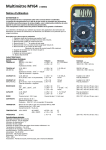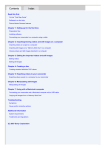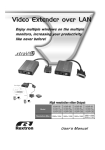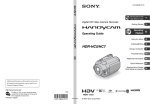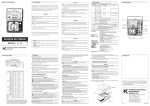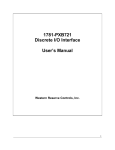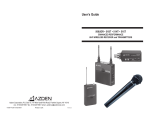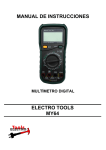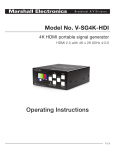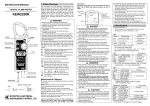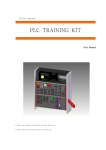Download MY SERIES
Transcript
HAND HELD DMM
MY
SERIES
OPERATOR'S MANUAL
1. SAFETY INFORMATION
.&. WARNING
To ensure safe operation, and in order to the full the functionality of
the meter, please follow the directions In this section carefully.
This multimeter has been designed according to EN61010-1:2001concerning
electronic measuring instruments with an overvoltage category CAT IL 600V
and potlu1ion 2. Follow all the instructions in tne manual to ensure that the meter
is used safely and kept in good operating condition. V\lith proper use and care,
the digital meter will give you years of satisfactory service.
This instrument is one of the series of compact pocket- sized 3 1/2 digit
multi meters for measuring DC and AC voltage, DC and AC current resistance
diode. measurement and audible continuity test.
Full range overload protection and low battery voltage indication are Provided.
They are ideal instruments for use in fields, such as laboratory, workshop, hobby
and home applications.
1.1 PRELIMINARY
1.1.1
When using the meter, the user must observe all normal safety rules
concerned.
1.1.2
Protection against the dangers of electrical current.
1.1.3
Protection of the meter against misuse.
1.1.4
When the meter is delivered, check that it has not been damaged in
1.1.5
When poor condition under harsh preservation or shipping conditions
1.1.6
Test leads must be in good oondition. Before using verify that the insulation
transit.
caused, inspect and confirm this meter without delay.
on test leads is not damaged and/or the leads wire is not exposed.
1.1. 7
Full compliance with safety standards can be guaranteed only if used
with test leads supplied. If necessary, they must be replaced with the
same model or same electric ratings.
1
1.2 DURING USE
1.2.1
1.2.2
Before using, you must select the right input jack, function and range.
Never exceed the protection limit values indicated in specifications for
each range of measurement.
1.2.3
W'hen the meter is linked to a measurement circuit, do not touch unused
1.2.4
At the manual range, when the value scale to be measured is unknown
terminals.
beforehand, set the range selector at the highest position.
1.2.5
Do not measure voltage if the voltage on the terminals exceeds 600V
above earth ground.
1.2.6
Always be careful when working with voltages above 60V DC or 30V
AC rms, keep fingers behind the probe barriers while measuring.
1.2.7
Never connect the meter leads across a voltage source while the
transform switch is in the current, resistance, diode, transistor or continuity
mode.
1.2.8
Before rotating the transform switch to change functions and ranges,
disconnect test leads from the circuit under test.
1.2.9
Never perform resistance, transistor, diode and continuity measurements
on live circuits.
1.2.10 Never use the meter under the condition of the explosive air, steam or
dirt.
1.2.11 If any faults or abnormalities are observed, the meter can not
be used
any more and it has to be checked out.
1.2.12 Never use the meter unless the rear case is in place and fastened fully.
1.2.13 Please do not store or use meter in areas exposed to direct sunlight,
high temperature, humidity or condensation.
1.2.14 Indoor working temperature 23'C±1, Humidity: 45%-75%
1.2.15 Don't use the instrument in the environment which is in high humidity
or air is not circulated. (For example, the basement, ice storage)
1.3 SYMBOLS
&.
Important safety information, refer to the operating manual.
CATll Overvoltage (Installation) category II ,Pollution Degree 2 per EN 610102
1 :2001
<E
.J...
...
*
-
-
hFE
refers to the level of Impulse Vllithstand Voltage protection provided.
Conforms to European Union directive
Earth ground
Diode
DC (direct current)
AC (alternating current)
Dangerous voltage may be present.
Double insulation (Protection Class II)
Optional equipment
Continuity buzzer
The battery is not sufficient for proper operation.
Separate collection for electrical and electronic equipment
Transistor test
KHz: Frequency
hole
Test
-E:r Fuse
s;z5 PTC Resettable Fuse
CAP Capacitance Test
1.4 MAINTENANCE
1.4.1 Please do not attempt to adjust or repair the meter by removing the rear
case while voltage is being applied.
A technician who fully understands danger involved should only carry
out such actions.
1.4.2 Before opening the battery cover or case of the meter, always disconnect
test leads from all tested circuits.
1.4.3 To avoid the wrong reading causing electricity attack, when the meter
displays"�", you must change the battery.
1.4.4 For continue protection against fire, replace fuse only with the specified
voltage and current ratings: Fuse 1: 10A/250V(quick acting) ,Fuse 2:
200mA/250V Resettable Fuse.
(•MY60 Fuse 2: 2A/250V) (quick acting)
1.4.5 Do not use abrasives or solvents on the meter, use a damp cloth and
mild detergent only.
1. Turn the meter OFF and remove the test leads.
2. Shake out any dirt that may be in the terminals.
3. Soak a new swab with isopropyl alcohol and work around the inside
of each input terminal.
4. Use a new swab to apply a light coat of the machine oil to the inside
of each terminal.
3
1.4.6
Always set the ON/OFF button to the OFF position when the meter is
1.4.7
If the meter is to be stored for a long period of time, the batteries should
not in use.
be removed to avoid d a m a g e .
2 . FRONT PANEL DESCRIPTION
(1)
DISPLAY
3 1 /2 digit 7 segment, 20mm high LCD
(2)
ON/OFF BUTION
This Button is used to switch power to
extend the life of the battery.
The button should be in the "OFP' state
1>-""'*Hi-
"-J!����J
when the instrument is not in use.
(3)
FUNCTION AND RANGE SWITCH
This switch is used to select the function
and desired range as well as to tum on
the instrument.
(4)
(hFE.
Temp. CAP.Jack)
Plug in connector with red (positive) test lead for current (expect 10A)
measurement. Multifunction Socket.
(5)
"10A"
Jack
Plug in connector with red (positive) test lead for 10A measurement.
(6)
"COM" Jack
Plug in connector with black (negative) test lead.
(7)
''V/ Q " Jack
Plug in connector with red (positive) test lead for all voltage and resistance
measurements.
4
MY SERIES
M¥60
MY61
MY62
MY63
MY64
200mV
"
./
./
20V
"
..;
"
"
"
"
2V
"
"
200V
"
600V
"
,/
"
"
"
2V
./
./
"
./
./
"
"
./
"
"
"
2mA
./
"
./
"
./
"
"
20mA
"
200mA
./
"
./
./
"
"
./
./
DCV
20V
ACV
200V
600V
DCA
2A
lOA
2mA
20mA
ACA
200mA
2A
"
./
./
./
"
,J
./
"
./
"
./
./
./
./
"
./
"
"
"
./
./
./
"
"
./
"
./
./
./
./
"
./
./
./
./
./
./
,J
"
"
./
2M
20M
./
./
"
"
./
./
200k
"
"
"
"
"
./
./
"
./
"
./
./
"
2k
20k
20n
./
200n
./
2u
"
./
./
./
./
-
Transistor Test
./
./
./
./
./
./
"
"
Diode Test
./
./
./
./
Continuity Buzzer
./
./
./
./
-
20u
./
Freq Test
./
-Temp Test
./
5
-
"
./
"
200
CAP
./
./
./
lOA
Resi
"
./
-
./
-
"
-
·
3. SPECIFICATIONS
Accuracy is specified for a period ofyear after calibration and at 18'C to 2a·c
(64•F to 82.F) with relative humidity to 75%.
3.1 GENERAL SPECIFICATIONS
•
MAX. Volltage Between Terminals And Earth Ground: 600V DC or AC
e
Fuse Protection:Fuse 1: 10A/250V Fuse 2: 200mA/250V
(•MY60 Fuse 2: 2A/250V
<t> 5 x 20mm)
rnA Terminal Fuse: 200mA/250 Resettable Fuse
•
10A Terminal
Fuse:<t> 5 x 20mm 10A/250V.(Fast)
Operating Altitude: 2000 meters (7000ft.) maximum
e
Display: 25mm LCD
e
MAX. Show Value: 1999 (3 1/2)
•
Polarity Indication: "-" indicates negative polarity.
•
Overrange Indication: Display "1"
•
Sampling Time: approx. 0.4 second
•
Auto Power Off
•
Unit showing: showing of function and electrical capacity.
•
Low Bettery Indication:"�" displayed
e
Power Supply: 9V 6F22
e
Operating Temperature:O'C to 40'C (32•F to 104.F)
•
Storage Temperature: -1o·c to 50"C (1o·F to 122·F)
e
Dimension: 189mm x 91mm x 32mm
•
VVeight: approx. 240g (including battery & holster)
3.2 ELECTRICAL SPECIFICATIONS
3.2.1 DC Voltage
Range
200mV
Accuracy
± 0.5%, of rdg ± 2 digits
Resolution
± 0.8%, of rdg ± 2 digits
10mV
2V
20V
1mV
200V
600V
100uV
100mV
±1.0 %,ofrdg ± 2 digits
1V
Input Impedance: 10M ohm on all ranges. Overload Protection: 600V de or peak
ac on all ranges.
Overload Protection: 200V rms AC for 200mV range and 600V DC or AC for
other ranges.
6
3.2.2 AC Voltage
Resolution
1mV
Range
2V
Accuracy
20V
± 0.8%, of rdg ± 3 digits
600V
10mV
100mV
200V
± 1.2%, of rdg
+
1V
3 digits
Input Impedance: 10M ohm on all ranges.
Frequency Range: 40Hz to 1kHz
Overload Protection: 220V rms AC for 200mV range and 600V DC or AC for
other ranges.
Indication: Average (rms of sine wave).
3.2.3 DC Current
Range
2mA
20mA
200mA
2A
10A
Accuracy
± 1.2%, of rdg ± 2 digits
± 1.5%, of rdg ± 2 digits
Resolution
1uA
10uA
0.1mA
1mA
± 2.0%, of rdg ± 5 digits
10mA
Overload Protection: Fuse 1: 10AI250V (10Aup to 15seconds).
Maximum input Current: Fuse 2:200mA1250V (Resettable fuse).
*
( MY60 Fuse 2: 2AJ250V).
Measuring Voltage Drop: 200 mV.
3.2.4 AC Current
Range
2mA
20mA
200mA
2A
10A
Accuracy
± 1.2%,
of rdg
Resolution
± 2 digits
± 1.8%, of rdg ± 2 digits
± 3.0%, of rdg ± 7 digits
Overload Protection: Fuse 1: 10A/250V (10Aup to 15seconds).
Indication: Average (rms of sine wave).
Maximum Input Current: Fuse 2: 200mA1250V (Resettable fuse).
*
( MY60 Fuse 2: 2AJ250V).
Measuring Voltage Drop: 200mV
Frequency Range: 40Hz to 1kHz
7
1uA
10uA
0.1mA
1mA
10mA
3.2.5
Resistance
Range
Accuracy
Resolution
200 ohm
0.1 ohm
2Kohm
±
2 0K ohm
200Kohm
0.8%, of rdg
± 1 . 2%,
2M ohm
20M ohm
+
±
1 ohm
2 digits
10ohm
100 ohm
of rdg
1 .8 %, of
±
2 digits
rdg + 2
1K ohm
10K ohm
digits
Overload Protect1on: 220V dc/ac rms on all ranges.
Open Circuit Voltage: Less than 750 mv.
3.2.6
Dio de
and Audible
Range
2K
*
Continuity Test
Description
Test Condition
Display read approximate forward
Forward
voltage of diode
approximately1 rnA.
DC
current
DC v o l t a g e
Reversed
app rox imate 2 . 8 Volts.
·ll)
200ohm
Built-in buzzer sounds if resistance
is less than approximate 50 0
C i rc u i t V o l t a g e
approximate 2.8 Volts.
O pe n
TEST CURRENT
10Hz
semsitirity: 200mV rms and input no more 10V rms
3.2.8 Trans i stor
hFE Test
Range
hFE
*3.2.9
Description
Test Condition
Disp l ay read approximate hFE va l ue
(1-IOOO)of transistor under test(ALL
Base Current approx IOuA
VCE approximate I y 2. 8
TYPE)
Volts.
CAPACITANGE
Range
Accuracy
Resolution
20nF
10pF
200nF
± 4 %, of rdg ± 5 digits
2u
20u
*3 210
0.1nF
1nF
10nF
TEMPERATURE
Range
-20't to
1000't
-20't
to O't
I
I
:1: 5.0% of rdg :1: 4digits
Accuracy
to 400't
:1: 1% of rdg :1: 3digits
O't
8
I
I
Resolution
to1OOO't
±2% of rdg
400't
1't
4. OPERATING INSTRUCTION
4.1 PREPARATION FOR MEASUREMENT
Check the 9-volt battery by setting the ON-OFF switch to ON. If the battery
is weak, a "�" sign will appear on the left of the display.
If this does not appear on the display, proceed as below. See MAINTENANCE
if the battery has to be replaced.
The ".&." besides the input jack shows that the input voltage or current should
be less than spedfication on the sticker of the meter to protect the inner circuit
from damaging.
Select a function and a range for the item to be measured through rotating
the switch accordingly. When the value scale to be measured is unknown
beforehand, set the switch at the highest position.
'Mlen connection, first connect to the public testing line, then to the electriferous
testing line. When you'll remove it. you should remove the electriferous one.
4.2 MEASURING DC VOLTAGE
&WARNING
You can't Input the voltage which more than 600V DC, It's possible
to show higher voltage, but it may destroy the inner circuit.
Pay attention not to get an electric sh ock when measuring high voltage.
(1) Connect red test lead to "VO ",Black
lead to "COM" jack.
(2) Put down the "ON/OFF BUTION" Set
RANGE switch to desired DCV position. If the
voltage to be measured is not known
0
beforehand, set switch to the highest range and
reduce it until satis-factory reading is obtained.
(3) Connect test leads to device or circuit
being measured.
(4) Tum on power of the device or circuit
being measured, voltage value will appear on
Digital Display along with the voltage polarity.
9
@@
A
n>\
NOTE:
e At the little voltage range, the meter will show unsteady reading when test
leads do
not
touch the circuit, it's normal because the meter is very
sensitivity. When test leads touch the circuit, you can get the true reading.
e When only the figure "1 " is displayed, it indicates overrange situation and
the higher range has to be selectred.
e When the value scale to be measured is unknown beforehand. set the range
switch at the highest position.
e
When the voltage measured is above600V,the buzzer is workin g it means that
the value tested is over-range,it's better not to measure voltage of large value.
,
4.3 MEASURING AC VOLTAGE
.&. WARNING
You can't Input the voltage which more than 600V nns AC, It's possible
to show higher voltage, but it's may destroy the inner circuit.
Pay attention not to get an electric shock when measuring voltage.
(1) Red lead to 'VO", Black lead to "COM" jack.
(2) Put down the "ON/OFF BUTTON"
RANGE switch to desired ACV position.
(3) Connect test leads to device or circuit
being tested.
(4) Read voltage value on Digital Display.
@@
NOTE:
e At the little voltage range, the meter will show unsteady reading when test
lead haven't reach the circuit. it's normal because the meter is very sensitivity.
When test leads touch the circuit, you can get the true reading.
e When only the figure "1" is displayed, it indicates overrange situation and
the higher range has to be selectred.
e When the value scale to be measured Is unknown beforehand. set the range
switch at the highest position.
e
When the voltage measured is above600V,the buzzer is wo rki ng it means that
the value tested is over-range,it's better not to measure voltage of large value.
,
10
4.4 MEASURING DC CURRENT
.& WARNING
Shut down the power of the tested circuit, then connect the meter
with the circuit for measurement.
(1) Red lead to" mA ",Black lead to "COM".
(For measurements 1OA connect red lead to
"10A" jack with fully depressed.)
(2) Put down the "ON/OFF BUTTON"
RANGE switch to desired DCA position.
(3) Open the circuit to be measured, and
connect test leads IN SERIES with the load in
which current is to be measured.
(4) Read current value on Digital Display.
@
A
NOTE:
e When only the figure "1" is displayed, it indicates overrange situation and
the higher range has to be selectred.
e When the value scale to be measured is unknown beforehand, set the range
switch at the highest position.
• 10A's maximum current is 10A.
• When testing in "10A" range, measuring no more than 10 seconds each
time. After first time test, do wait for 15 minutes. Until the temperature
drops (the LCD display 0), then you can begin another current test.
4.5 MEASURING AC CURRENT
_&WARNING
Shut down the power of the tested circuit, then connect the meter
with the circuit for measurement.
(1) Red lead to " mA ",Black lead to "COM". (For measurements
1OA connect
red lead to "10A" jack with fully depressed.)
(2) Put down the "ON/OFF BUTTON'', RANGE switch to desired ACA position.
(3) Open the circuit to be measured, and connect test leads IN SERIES with
the load in which current is to be measured.
(4) Read current value on Digital Display.
11
NOTE:
• When only the figure "1" is displayed, it
II
indicates overrange situation and the higher
range has to be selectred.
• When the value scale to be measured is
C)
unknown beforehand, set the range switch
�
at the highest position.
e 10A's maximum current is 10A.
• When testing in "10A" range, measuring no
more than 10 seconds each time.After first
time test, do wait for 15 minutes. Until the
temperature drops (the LCD display 0), then
n
@w (1
A
@
VCUb
n
you can begin another current test.
4.6 MEASURING RESISTANCE
.&. WARNING
When measuring in-circuit resistance, be sure the circuit under test
has all power removed and that all capacitors have been dis charged
fully.
{1) Red lead to 'VO", Black lead to "COM"
jack.
{2) Put down the "ON/OFF BUTTO N "
RANGE switch to desired OHM position.
{3) If the resistance being measured is
connected to a circuit, turn off power and
discharge all capacitors before measurement.
{4) Connect test leads to circuit being
measured..
D�
�
C)
@@
A
{5) Read resistance value on Digital Display.
NOTE:
""' <
, vj n
�
e When only the figure "1" is displayed, it indicates overrange situation and
the higher range has to be selectred.
e When the input is not connected, i.e. at open circuit, the figure "1" will be
displayed for the overrange condition.
12
4.7 DIODE MEASURING
(1) Red lead to 'VO", Black lead to "COM".
(2) Put down the "ON/OFF BUTTON" Set
0
RANGE switch to * position.
(3) Connect the red test lead to the anode
of the diode to be measured and black test lead
to cathode.
(4) The forward voltage drop in mv will be
dislayed. If the diode is reversed, figure "1" will
@@
A
m\
(
be shown.
4.8 TESTING CONTINUITY BUZZER
.&. WARNING
When testing the circuit continuity, be sure that the power of the
circuit has been shut down and all capacitors have been discharged
fully.
(1) Connect the black test lead to the COM jack and the red test lead to
the 'VO" jack.
(2) Put down the "ON/OFF BUTTON". Set the transtorm switch at the".,,, ..
range position.
(3) Connect test leads across two points of
the circuit under testing.
(4) If continuity exists (i.e., resistance less
than about 50 0 ), built·in buzzer will sound.
NOTE:
e If the inut open circuit (or the circuit
resistance measured is higher than 20000)
then the figure "1" will be displayed.
D A-�
j
(}
0
@@
A
13
""
(
j\'v,
�
4.9 TESTING TRANSISTOR
(1) Set the transform switch at range
position.
(2) Connect the Black test lead to "COM" jack
and transistor "COM" jack. The Red test
lead to "mA" jack
(3) Identify whether the transistor is NPN or
ID
w
©
A
I
NOTE:
©
({ \'(UI
Do not put the plug into the wrong jack.
�
J
C>
�
.
*4.11
ft
)
�
*4.10 MEASURING FREQU ENCY
(1) Set the rotary switch at 20kHz
(2) Red lead to "VO'', Black lead to "COM"ja ck.
(3) Cnnect test leads to circuit being measured
(4) Read resistance value on Dgital Dsplay
NOTE:
Reading is possible at input voltages above
1 OVrms but the accuracy is not guaranteed
In noisy environment, it is preferable to use shield
cable for measuring small signal
!IPH PHP
uwu
.
j
�
C>
PNP type and insert emitter base and collector
leads into the proper holes of the transistor on
the multifunction test socket for testing.
(
©@
A
"''
i
,,.a
_s;.==..
MEASU RI NG CAPACITANCE
(1) Set the rotary switch at "F" position
(2) Connect the Black test lead to "COM" jack
and multifunctional Measuring "COM" jack,
and t he Red test lead to "mA" jack
(3) Before inserting capacitor under
measurement into the multifunctional "CX"
jack, be sure that the capacitor has been
discharged fully
(4) Read LCD display
NOTE:
Din' t insert the plug wrong jack
Set the rotary switch at the highest position when
the capacity was unknown
14
cu�" )
C>
�
©
A
w
©
C( VOH1
h
I
Q
*4.12 MEASURING TEMPERATURE
(1) Set the rotary switch at "TEMP" position
and the LCD display will Show the
normal environment temperature
(2) Connect the Black test lead to "COM"
jack and multifunctional measuring
"COM" jack, and t he Red test lead to
"rnA" jack
(3) In sert "K" type theromcouple into the
multifunctionde measuring "K" jack and
contact the object to be measured with
the thermocouple probe
(4) Read LCD display
NOTE:
Don' t insert the plug into wrong jack
Don' t insert the wrong place of thermocouple' s
anode and cathode
c-��-�=-+)
��
CJ A
'
�
0
�w
@
l VUH
u
5. MAINTENANCE
5.1 BATTERY REPLACEMENT
.&. WARNING
Before attempting to open the battery cover of the meter, be sure that
test leads have been disconnected from measurement circuit to avoid
electric shock hazard.
(1) If the sign"�" appears on the LCD display, it indicates that the battery
should be
replaced.
the screw fixing the battery cover and remove it.
(2) Loosen
(3) Replace the exhausted battery with a new one.
(4) Put the battery cover as its origin.
CAUTION:
• Risk of explosion if battery is r eplaced
by an incorrect type Replace on l y with the
same orequivalent type.
•
Rep I ace of used batties according to the relevant regu lation
15
5.2 FUSE REPLACEMENT
& WARNING
Before attempting to open the battery cover of the meter, be sure that
test leads have been disconnected from measurement circuit to avoid
electric shock hazard.
For protection against fire, replace fuses only with specified ratings:
Fuse 1: 1OA /250V(quick acting).
(*MY60
F use 2 : 2A/250V)
Fuse 2: 200mA/250V (Resettable fuse)
(1) Fuse seldom need replacement and blow almost always as a result of
the operator's error.
(2) Loosen the fixing screw of the case and remove it.
(3) Replace the blown fuse with ratings specified.
(4) Put the case as its origin.
NOTE: In order to prevent damage and hurt, it can only be installed or
replace the fuse with designated amperes and voltage.
5.3 TEST LEADS REPLACEMENT
& WARNING
Full in compliance with safety standards can be guaranteed only if
used with test leads supplied. If necessary, they must be replaced
with the same model or same electric ratings. Electric ratings of the
test leads: 1 OOOV 1 OA.
You must be replaced the test leads if the lead is exposed.
6.0VER-RANGE INDICATION
Range
Accuracy
Resolution
5%+5digits
DC600V
+
AC600V
± 5%+ 1d igit
1V
1V
NOTE:
During the above range, when the LCD displays"1", it indicates over-range.
7 .ACCESSORIES
(1} Test Leads: Electric Ratings1000V 10A
one set
(2) Battery: 9V 6F22
one piece
(3) Operating Manual
one piece
(4) Multifunction socket
one piece
*(5) "K" type thermocouple HYTP-105
one piece
one piece
(6) holster
16


















